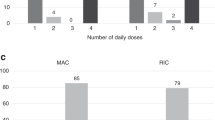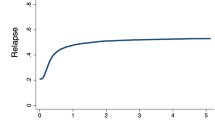Abstract
Considerable progress has been made in improving the control of chemotherapy-induced emesis. The impact of available antiemetic options for patients receiving stem cell transplants is unclear, as few prospective data have been collected. We prospectively evaluated antiemetic outcome in patients receiving stem cell transplantation over a 7-day period following the initiation of chemotherapy. The primary endpoints were the number of emetic episodes and the extent of nausea measured on a four-point scale. Eighty-two patients were evaluated. Ninety-five percent of patients had nausea during the first week of treatment; 80% had at least one emetic episode. The percentage of patients with emesis was as follows: day 1: 13%, day 2: 21%, day 3: 30%, day 4: 38%, day 5: 44%, day 6: 39%, day 7: 18%. In multivariate analysis, gender, emesis with prior chemotherapy, history of morning or motion sickness, type of transplant (auto vs allo), use of total body irradiation, or use of dexamethasone did not effect emesis control. Most patients receiving high-dose chemotherapy experience incompletely controlled emesis. Control of nausea and emesis progressively worsened with each subsequent day following initiation of chemotherapy, reaching a nadir on day 5. New treatment approaches are needed to improve emesis control in this patient population.
Bone Marrow Transplantation (2001) 28, 1061–1066.
This is a preview of subscription content, access via your institution
Access options
Subscribe to this journal
Receive 12 print issues and online access
$259.00 per year
only $21.58 per issue
Buy this article
- Purchase on Springer Link
- Instant access to full article PDF
Prices may be subject to local taxes which are calculated during checkout


Similar content being viewed by others
References
Thomas ED, Clift RA, Fefer A et al. Marrow transplantation for the treatment of chronic myelogenous leukemia Ann Intern Med 1986 104: 155–163
Krivit W, Whitley CB . Bone marrow transplantation for genetic disease New Engl J Med 1987 316: 1085–1087
Lucarelli G, Galimberti M, Polchi P et al. Marrow transplantation in patients with advanced thalassemia New Engl J Med 1987 316: 1050–1055
Mickelson E, Petersdorf EW . Histocompatibility. In: ED Thomas, KG Blume, SJ Forman (eds). Hematopoietic Cell Transplantation, 2nd edn Blackwell Science: Massachusetts 1999 p 28
Storb R, Deeg HJ, Whitehead J et al. Methotrexate and cyclosporine compared with cyclosporine alone for prophylaxis of acute graft versus host disease after marrow transplantation for leukemia New Engl J Med 1986 314: 729–735
Goodrich JM, Mori M, Gleaves CA et al. Early treatment with ganciclovir to prevent cytomegalovirus disease after allogeneic bone marrow transplantation New Engl J Med 1991 325: 1601–1607
Rubinstein P, Carrier C, Scaradavou A et al. Outcomes among 562 recipients of placental blood transplants from unrelated donors New Engl J Med 1998 339: 1565–1577
Coates A, Abraham S, Kaye SB et al. On the receiving end: patient perception of the side-effects of cancer chemotherapy Eur J Cancer Clin Oncol 1983 19: 203–208
Griffin AM, Burtow PN, Coates AS et al. On the receiving end V: patient perceptions of the side effects of the cancer chemotherapy in 1993 Ann Oncol 1996 7: 189–195
Navari RM, Kaplan HG, Gralla RJ et al. Efficacy and safety of granisetron, a selective 5-hydroxytryptamine-3 receptor antagonist, in the prevention of nausea and vomiting induced by high-dose cisplatin J Clin Oncol 1994 12: 2204–2210
Riviere A . Dose finding study of granisetron in patients receiving high-dose cisplatin chemotherapy Br J Cancer 1994 69: 967–971
Gralla RJ, Navari RM, Hesketh PJ et al. Single-dose oral granisetron has equivalent antiemetic efficacy to intravenous ondansetron for highly emetogenic cisplatin-based chemotherapy J Clin Oncol 1998 16: 1568–1573
Hesketh PJ, Navari R, Grote T et al. Double-blind, randomized comparison of the antiemetic efficacy of intravenous dolasetron mesylate and intravenous ondansetron in the prevention of acute cisplaitin-induced emesis in patients with cancer J Clin Oncol 1996 14: 2242–2249
Hesketh PJ, Plagge P, Bryson JC . Single-dose ondansetron for prevention of acute cisplatin-induced emesis: analysis of efficacy and prognostic factors. In: Bianchi AL, Grelot L, Miller AD et al (eds) Mechanisms and Control of Emesis Libbey: London 1992 pp 25–26
Beck TM, Hesketh PJ, Madajewicz S et al. Stratified, randomized, double-blind comparison of intravenous ondansetron administered as a multiple-dose regimen versus two single-dose regimens in the prevention of cisplatin-induced nausea and vomiting J Clin Oncol 1992 10: 1969–1975
Trovato JA, Stull DM, Finley RS . Outcomes of antiemetic therapy after the administration of high-dose antineoplastic agents Am J Health Syst Pharm 1998 55: 1269–1274
Perez EA, Tiemeier T, Solberg LA . Antiemetic therapy for high-dose chemotherapy with transplantation: report of a retrospective analysis of a 5-HT3 regimen and literature review Support Care Cancer 1999 7: 413–424
Armitage P, Berry G . Statistical Methods in Medical Research, 3rd edn Blackwell: Boston 1994 pp 422–436
Gralla RJ, Osoba D, Kris MG et al. Recommendations for the use of antiemetics: evidence-based, clinical practice guidelines J Clin Oncol 1999 17: 2971–2994
Abbott B, Ippoliti C, Bruton J et al. Antiemetic efficacy of granisetron plus dexamethasone in bone marrow transplant patients receiving chemotherapy and total body irradiation Bone Marrow Transplant 1999 23: 265–269
Osowksi CL, Dix SP, Lynn M et al. An open-label dose comparison study of ondansetron for the prevention of emesis associated with chemotherapy prior to bone marrow transplantation Support Care Cancer 1998 6: 511–517
Abbott B, Ippoliti C, Hecth D et al. Granisetron (Kytril) plus dexamethasone for antiemetic control in bone marrow transplant patients receiving highly emetogenic chemotherapy with or without total body irradiation Bone Marrow Transplant 2000 25: 1279–1283
Orchard PJ, Rogosheske J, Burns L et al. A prospective randomized trial of the anti-emetic efficacy of ondansetron and granisetron during bone marrow transplantation Biol Blood Marrow Transplant 1999 5: 386–393
Barbounis V, Koumakis G, Hatzichristou H et al. The anti-emetic efficacy of tropisetron plus dexamethasone in patients treated with high-dose chemotherapy and stem cell transplantation Support Care Cancer 1999 7: 79–83
Spitzer TR, Friedman CJ, Bushnell W et al. Double-blind, randomized, parallel-group study on the efficacy and safety of oral granisetron and oral ondansetron in the prophylaxis of nausea and vomiting in patients receiving hyperfractionated total body irradiation Bone Marrow Transplant 2000 26: 203–210
Ioannidis JP, Hesketh PJ, Lau J . Contribution of dexamethasone to control of chemotherapy-induced nausea and vomiting: a meta-analysis of randomized evidence J Clin Oncol 2000 18: 3409–3422
Bountra C, Bunce K, Dale T et al. Antiemetic profile of a non-peptide neurokinin NK1 receptor antagonist CP-99,994 in ferrets Eur J Pharmacol 1993 249: R3–R4
Watson JW, Gonsalves SF, Fossa AA et al. The anti-emetic effects of CP-99,994 in the ferret and the dog: role of the NK1 receptor Br J Pharmacol 1995 115: 84–94
Tattersall FD, Rycroft W, Hill RG, Hargreaves RJ . Enantioselective inhibition of apomorphine-induced emesis in the ferret by the neurokinin1 receptor antagonist CP-99,994 Neuropharmacology 1994 33: 259–260
Navari RM, Reinhardt RR, Gralla RJ et al. Reduction of cisplatin-induced emesis by selective neurokinin-1-receptor antagonist New Engl J Med 1999 340: 190–195
Hesketh PH, Gralla RJ, Webb RT et al. Randomized phase II study of the neurokinin 1 receptor antagonist CJ-11,974 in the control of cisplatin-induced emesis J Clin Oncol 1999 17: 338–343
Acknowledgements
The authors thank the outstanding nursing staff of the UMassMemorial Bone Marrow Transplant Unit. The authors thank Carol Perch and Shelly Anderson for their excellent technical assistance.
Author information
Authors and Affiliations
Rights and permissions
About this article
Cite this article
Ballen, K., Hesketh, A., Heyes, C. et al. Prospective evaluation of antiemetic outcome following high-dose chemotherapy with hematopoietic stem cell support. Bone Marrow Transplant 28, 1061–1066 (2001). https://doi.org/10.1038/sj.bmt.1703280
Received:
Accepted:
Published:
Issue Date:
DOI: https://doi.org/10.1038/sj.bmt.1703280
Keywords
This article is cited by
-
Antiemetic prophylaxis with fosaprepitant and granisetron in pediatric patients undergoing allogeneic hematopoietic stem cell transplantation
Journal of Cancer Research and Clinical Oncology (2020)
-
Palonosetron and dexamethasone for the prevention of nausea and vomiting in patients receiving allogeneic hematopoietic stem cell transplantation
Supportive Care in Cancer (2014)
-
Efficacy of aprepitant in preventing nausea and vomiting due to high-dose melphalan-based conditioning for allogeneic hematopoietic stem cell transplantation
International Journal of Hematology (2014)
-
Aprepitant for the control of delayed nausea and vomiting associated with the use of high-dose melphalan for autologous peripheral blood stem cell transplants in patients with multiple myeloma: a phase II study
Supportive Care in Cancer (2014)
-
Antiemetic therapy for multiple-day chemotherapy and additional topics consisting of rescue antiemetics and high-dose chemotherapy with stem cell transplant: review and consensus statement
Supportive Care in Cancer (2011)



